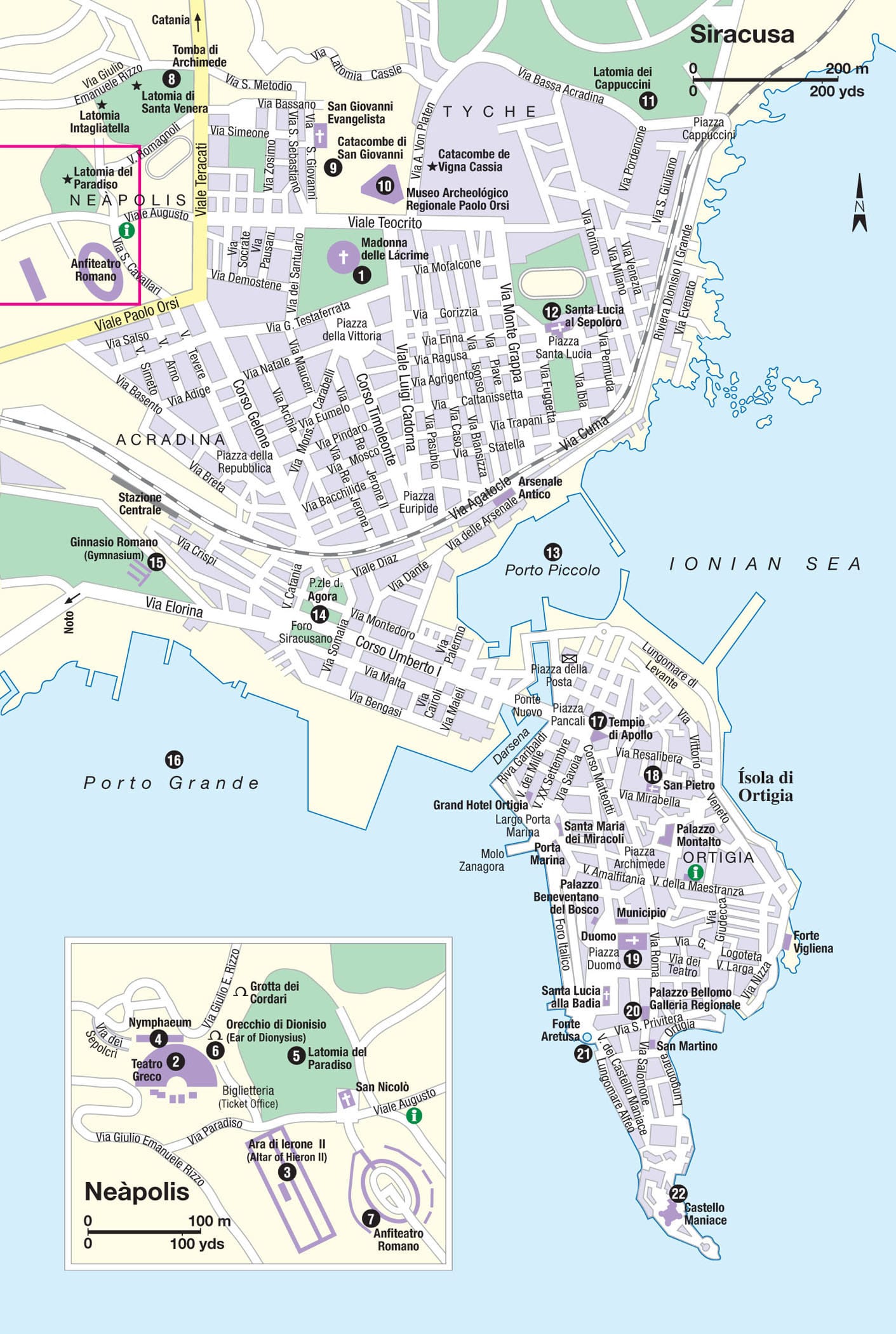Cicero called the island of Ortigia, part of the city of Siracusa today but separated from the mainland by a narrow channel, the loveliest city in the world, and, like Siracusa itself (Syracuse in English-speaking countries), Ortigia's name resounds in academic circles abroad. Siracusa is the summation of Sicilian splendour, with an emphasis on Greek heritage. It was this cultivated city that supposedly witnessed the birth of comedy in its Greek theatre and now boasts the only school of classical drama outside Athens.
Apart from tales of Artemis and Apollo, Siracusa gave the world architectural beauty with a Baroque heart: Ortigia has facades framed by wrought-iron balconies that are as free as billowing sails. In fact, as Sicily's greatest seafaring power, Siracusa indulged an affinity with the sea that still pervades city myths and art. The city's sensual sculpture of Venus emerging from the breeze-swept sea embodies this cult of water.
Perhaps daunted by such a glorious past, today's citizens have a reputation for being dreamers and underachievers, better at wallowing in the past than at preserving it for posterity. But the end result is a city of such languid charm that it feels pernickety to point out such failings. Arguably more beautiful than Ragusa, Siracusa offers the marine nonchalance Ragusa Ibla lacks, while urban regeneration in the island heart of Siracusa is making the city lovelier than ever.
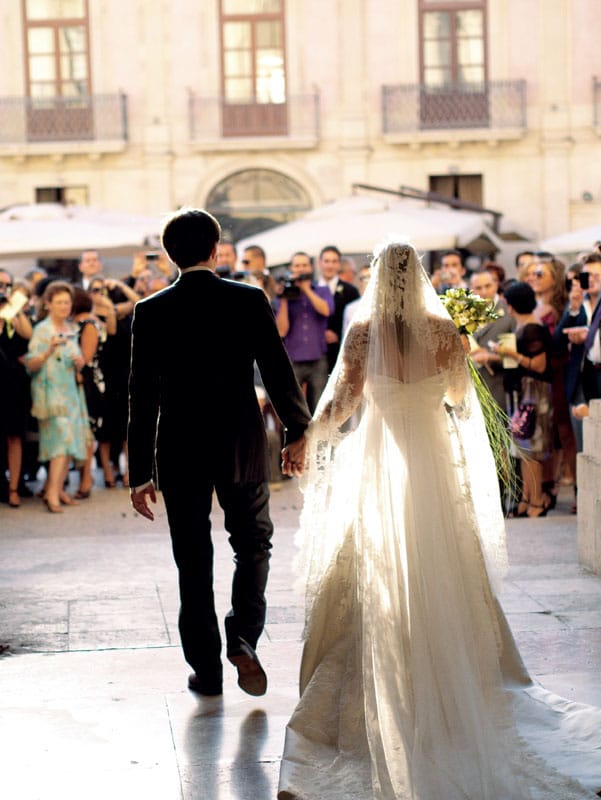
Marriage in Siracusa.
Neil Buchan-Grant/APA
Classical glory
The city was founded in 733 BC, a year after Naxos, by Corinthian settlers who maintained links with Sparta. Although it was ruled by a succession of cruel but occasionally benevolent tyrants, Siracusa rose to become the supreme Mediterranean power of its age under Dionysius the Elder. The decisive battle was Siracusa's defeat of Athens in 415 BC at sea. During a despotic 38-year rule, however, Dionysius personified Sicilian tyranny.
Tip
Although Ortigia would be a perfect spot for cycling, all the new bicycle ranks have been permanently vandalised, so visitors are restricted to lovely walks or to the tourist train which covers the city's main sites (picked up in Piazza Archimede, and operational until mid-October).
City sectors
Siracusa is a diffuse, segmented city whose ancient Greek divisions still resonate deeply with residents. Ortigia, the cultural island at the heart of the Greek city, remains true to its vocation: despite a grand Baroque and Catalan carapace, this beguiling backwater feels intimate, informal and quietly cultured. This is where the locals while away the long summer evenings.
By contrast, Tyche, the northern quarter on the mainland, can feel like the city of the dead: studded with ancient catacombs. Tyche lay beyond the bounds of Roman Syracuse and thus remains a testament to the impact of early Christianity. Acradina, bordering Ortigia, remains the commercial quarter, complete with railway station, while Neàpolis, to the northwest, though no longer “new”, still embodies the ancient Greeks’ notion of public and sacred space, ranging from theatres to sanctuaries.
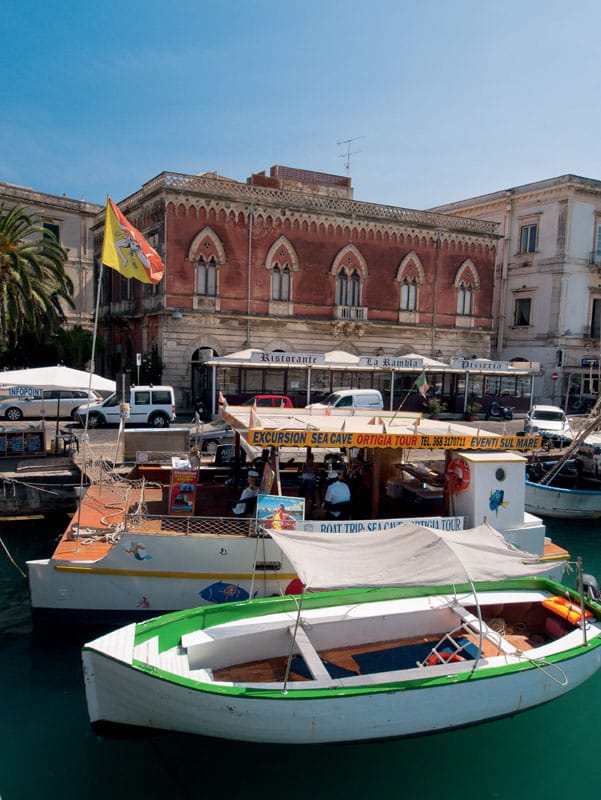
Darsena, the docks at Siracusa.
Neil Buchan-Grant/APA
Both as a useful landmark and as an antidote to classical beauty, the ugly modern Santuario della Madonna delle Lacrime 1 [map] signals the way to the archaeological zones of Neàpolis and Tyche. Visible from most of the city with its statue of the Madonna on top, this popular pilgrimage centre (daily 7am–8pm; www.madonnadellelacrime.it) commemorates a modern miracle: in 1953 a statue of Mary reputedly cried for five days and the spot became a shrine in the shape of a giant teardrop.
The legacy of Dionysius
Dionysius was a megalomaniac, a military strategist, a monumental builder, an inspired engineer and an execrable tragedian. He presided over Siracusa's golden age, with the grandest public works in the Western world. After the sun set on ancient Greece, Siracusa became a Roman province and was supposedly evangelised by St Peter and St Paul on their way to Rome. It became the capital of Byzantium, albeit briefly, in the 7th century and produced several popes and patriarchs of Constantinople. After being sacked by the Arabs in AD 878 and the Normans in 1085, the city sank into oblivion but quietly prospered under Spanish rule.
To the west, Neàpolis, the ancient quarter, is synonymous with its sprawling archaeological park, Parco Archeologico della Neàpolis (Tue–Sun 9am–5pm, Sun 8am–1pm; charge), containing rough-hewn quarries, grandiose theatres and tombs. Although set among shady fir trees and olive groves, the site can be sweltering in summer. But it's easy enough to avoid the tawdry stalls selling painted papyrus scrolls and melt into the spacious Greek ruins.
Teatro Greco
In the park, a stroll to the Teatro Greco 2 [map] passes the rubble of the Ara di Ierone II (Altar of Hieron II) 3 [map], a sacrificial altar once decorated by imposing telamones(giants). Surrounded by trees, the vast open theatre seats 15,000 and is often called the masterpiece of ancient Greece.
This astonishing accomplishment dates from 474 BC, although much was altered in the 3rd century BC. Carved into the rock, the cavea (horseshoe of tiered seats) is divided into two by a diazoma(corridor), and vertically cut into nine blocks of seats bearing inscriptions to deities and dignitaries. A satisfying climb to the top provides striking views over modern Siracusa and the sea. On the terrace is a nymphaeum 4 [map], a complex of waterfall, springs and grotto that once contained statues and niches for votive offerings.
In the Roman era, the theatre became an amphitheatre, with water dammed and diverted to flood the arena for mock naval battles or gladiatorial combat. But, among the Greeks, it was a stage that witnessed the first performances of all Aeschylus's tragedies. The theatrical tradition is maintained today, with the dramas of Sophocles and Euripides played on a stage once viewed by such notables as Plato and Archimedes.
Although partially closed, above the theatre, Via dei Sepolcri is a path of tombs, offering glimpses of tombs and carved niches at the upper level, while the lower level leads down to the latomie, giant quarries that were also used as prisons in classical times. A wooded path slopes behind the back of the Greek theatre to a secret rocky arch and the lush Latomia del Paradiso 5 [map]. These ancient quarries were once vaulted but are now open to the sun, bursting with olive and citrus groves or overgrown with cacti and ferns.

The Ear of Dionysius, a man-made cave named by Caravaggio.
Neil Buchan-Grant/APA
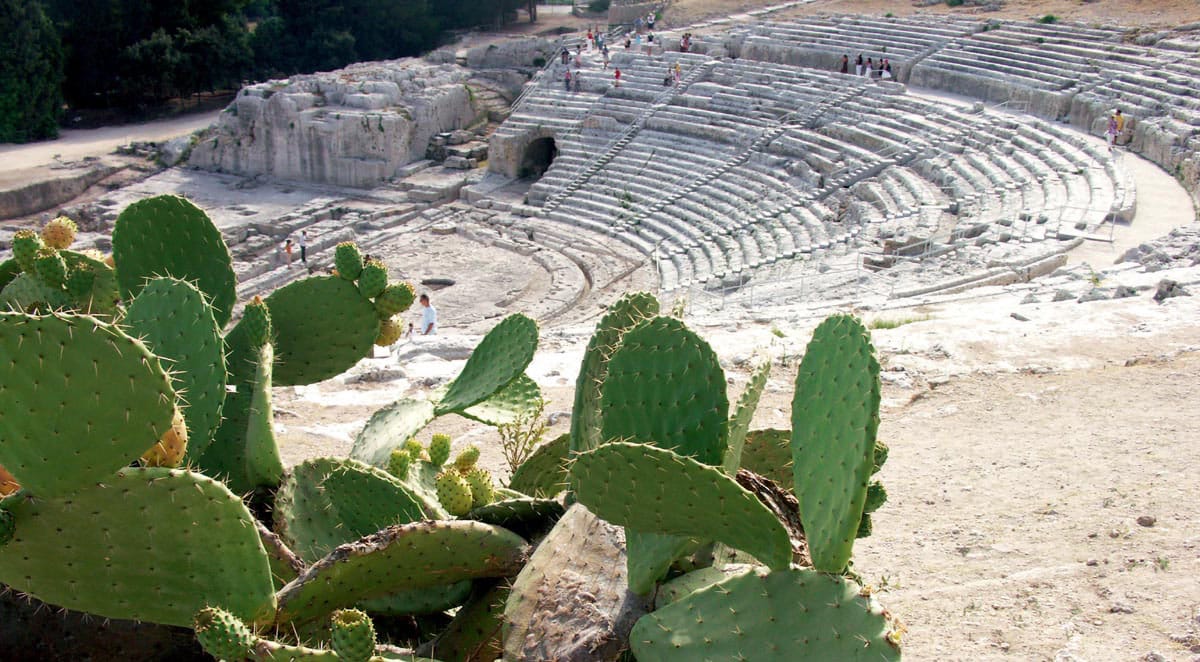
Teatro Greco.
Neil Buchan-Grant/APA
Here, too, is the cavernous Orecchio di Dionisio (Ear of Dionysius) 6 [map], man-made and in places 47 metres (154ft) high, with excellent acoustics. It was given its name by Caravaggio after its resemblance to an ear. The poetic painter fancied that this echoing, dank, weirdly shaped cave was used by Dionysius to eavesdrop on his prisoners.
Tip
The Papyrus Museum may be closed, but Egyptian papermaking techniques linger on in Siracusa. Various studios throughout the city offer to reproduce anything in papyrus, from old masters on papyrus to holiday snapshots on parchment.
The adjoining Grotta dei Cordari (currently closed) is scored with chisel marks, because it was here that rope makers (cordari) stretched out their damp strands and tested their ropes for stress. A tunnel links Latomia del Paradiso with Latomia Intagliatella, and a rocky arch leads on to Latomia di Santa Venera, lemon-scented quarries which are pitted with votive niches.
It is hard to imagine that these lush gardens were once torture chambers. After Siracusa's decisive victory over Athens, the prisoners of war were lowered by rope into these pits. There was no need to mount guard: keeping captives alive involved no more than lowering a slave's half-rations and a drop of water. After 10 gruelling weeks, the non-Athenians who had survived were hauled out and sold as slaves. Athenians were branded with the mark of the Siracusan horse and also sold as slaves.
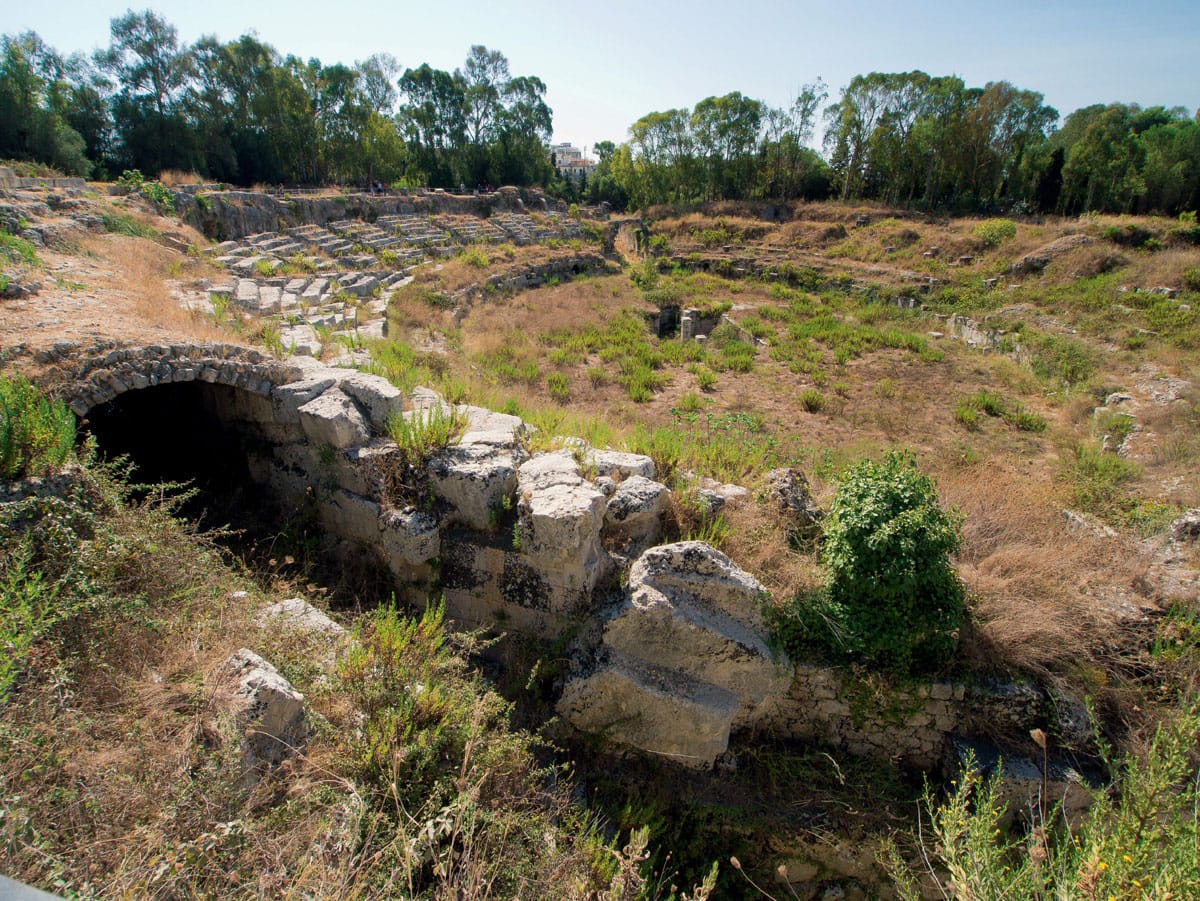
Roman amphitheatre.
Neil Buchan-Grant/APA
Roman amphitheatre
A separate entrance (but the same ticket) leads to the Anfiteatro Romano 7 [map], the Roman amphitheatre ringed by trees. While this tumbledown affair is not comparable with, say, the amphitheatre in France, at Nîmes, the site has charm. A path lined with stone sarcophagi leads to the imposing theatre carved by master craftsmen. Below a parapet circling the arena is a corridor where both animals and gladiators made their entrances for the spectacles.
Between the Greek theatre and Roman amphitheatre is San Nicolò, a Romanesque church concealing a Roman cistern. A circuit along Via Giulio Emanuele Rizzo reveals a cross-section of the classical city, including an aqueduct and the tomb-studded Via dei Sepolcri.
Ancient tombs
Further uphill lie the Necropoli delle Grotticelli, a warren of Hellenistic and Byzantine tombs, including the supposed Tomba di Archimede (Tomb of Archimedes) 8 [map], framed by a dignified Roman portico. The Romans insisted that Archimedes’ death was accidental, despite his creation of diabolical death traps used against them during the city's siege. This quarter forms part of ancient Tyche, characterised by labyrinthine catacombs that often follow the course of Greek aqueducts.
The Catacombe di San Giovanni 9 [map] (San Giovanni Catacombs; daily, 9.30am–noon, 2.30–5pm; charge) provide entry to the persecuted world of the early Christians. Escorted by a friar, visitors view early Christian sarcophagi, a 4th-century drawing of St Peter and a mosaic depicting Original Sin. The galleries open into space-creating rotundas decorated with primitive frescoes and arcane symbols, including a mysterious fish-headed boat or dead dove bound by an alpha and omega. Could this be a secret Christian code? Or a pagan transmigration of souls? Academics disagree.
In the wild garden outside is the shell of San Giovanni Evangelista, with its rose window and sculpted door often masked by monastic underwear drying in the sun. This modest church was Siracusa's first cathedral and is dedicated to St Marcian, the city's earliest bishop. Crooked steps lead down to Cripta di San Marziano and more catacombs. Light filters in on faded frescoes of St Lucy, sculpted cornices and an altar supposedly used by St Paul. Amid Greek lettering and crosses are primitive depictions of a phoenix and a bull.
Museum of Archeology
Probably the finest archaeological collection in Sicily lies in Villa Landolina, fittingly built over a quarry and pagan necropolis, in the Museo Archeologico Regionale Paolo Orsi ) [map] (Tue–Sat 9am–6pm, Sun 9am–1pm; charge; tel: 0931 464 022) on the neighbouring Viale Teocrito. The well-organised museum reveals a succession of superb collections, prehistoric and Greek, coming from Siracusa and its colonies, including finds at Gela and Agrigento. In the prehistory section, the stars are reconstructed necropoli, earthenware pots from Pantalica, and depictions of Cyclopes and dwarf elephants.
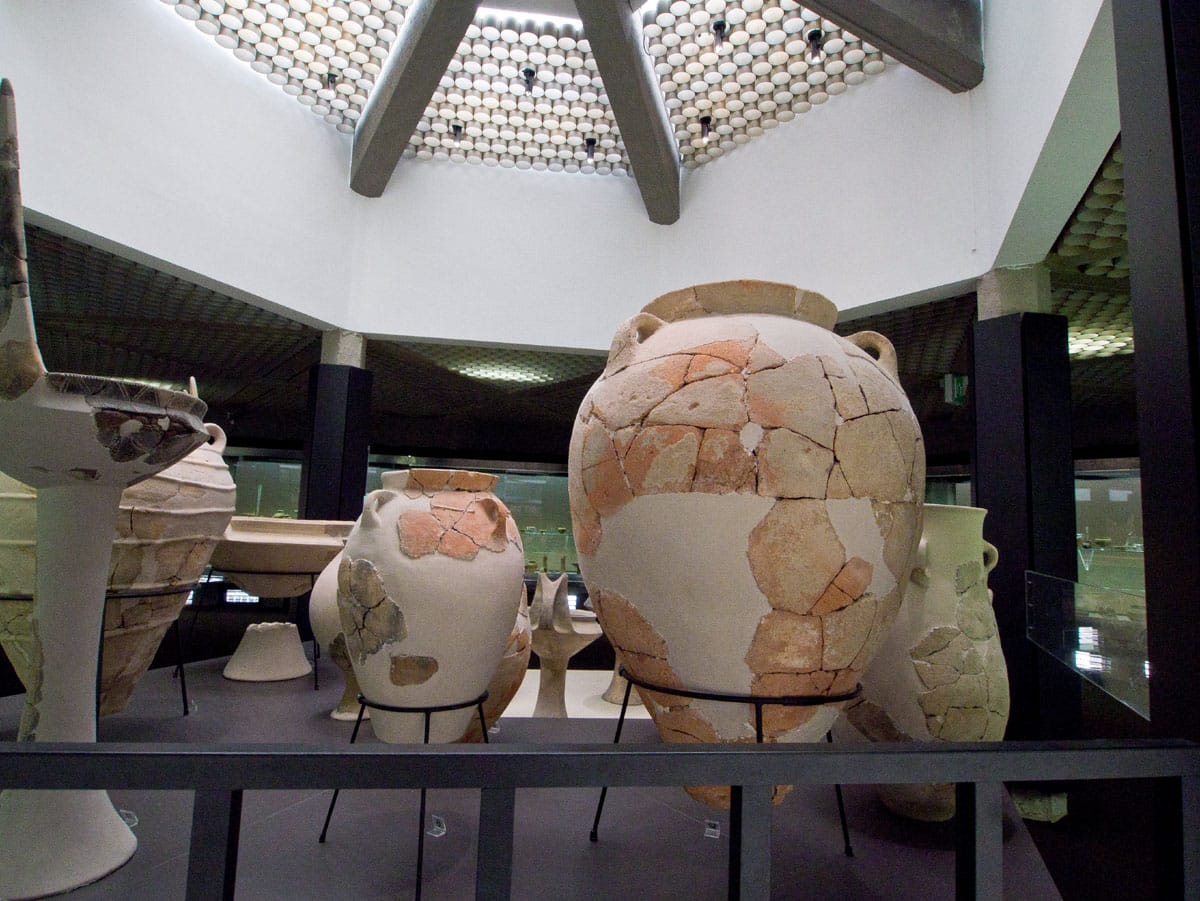
Exhibition at the Museo Archeologico Regionale Paolo Orsi.
Neil Buchan-Grant/APA
In the classical sections, the tone is set by two strikingly different works: the “immodest modesty” of the headless Venere Anadiomene (known also as Venus Landolina because it was unearthed here where the villa stands) and an Archaic sculpture of a seated fertility goddess suckling her twins, found in Megara Hyblaea. Elsewhere, the collection bursts with beauty and horror: lion's-head gargoyles, Aztec-like masks, a Winged Victory, a terracotta frieze of grinning gorgons and a Medusa with her tongue lolling out. Away from the horrors, smoothly virile marble torsos of kouroi(heroic youths) await. Beauty, both pure and sensual, lingers in the Roman sarcophagus of a couple called Valerius and Adelphia and in fragments of friezes from Selinunte and Siracusa.
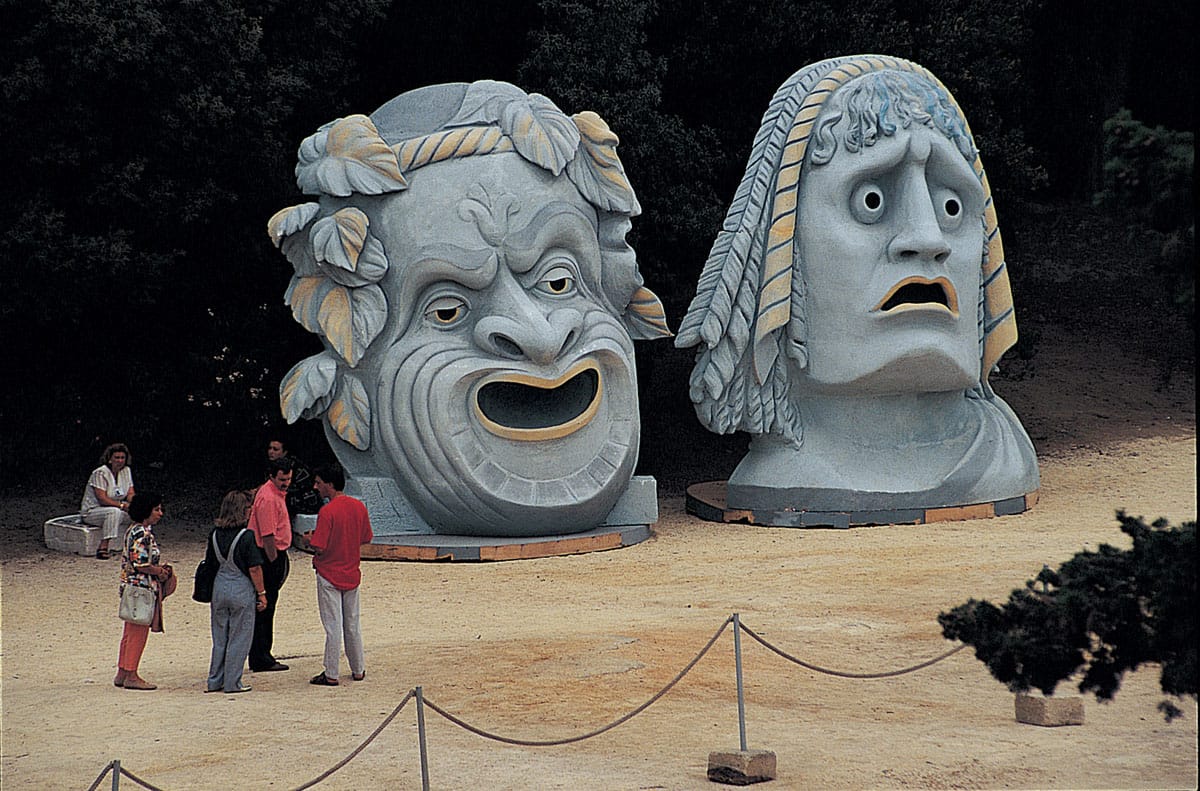
Giant statues of classic masks from Greek drama.
Neil Buchan-Grant/APA
Off the adjoining Via Augusto Von Platen are the Catacombe di Vigna Cassia, catacombs with 3rd-century tombs and frescoed chambers which lead on to Latomia dei Cappuccini ! [map], the most picturesque quarries, alongside a former Capuchin monastery. Set on the coast, these huge honeycombed pits are matched by sculptural vegetation, but currently they can only be viewed from Via Acradina above. From the adjoining Piazza Cappuccini are stirring views of the rocky shore.
The Eureka Man
Archimedes was no mere theoretician but an intensely practical inventor, master engineer and scientist when Siracusa was the most inventive place on earth
The image of Archimedes leaping from his bath with a cry of Eureka! (Greek for “I have found it”) is, despite the efforts of generations of physics teachers, not based in fact. While testing a gold crown suspected of being a mere alloy, Archimedes realised that the mass of water displaced by an object reveals its volume, and the mass of the object divided by its volume gives its density. The crown was found to be a fake as its density was less than that of solid gold. This discovery became known as Archimedes’ Principle: the principle of specific gravity and the basis of hydrostatics.
Born in 287 BC, Archimedes worked for Hieron, the tyrant of Siracusa. While watching the tyrant's marine engineers, he devised theories worth a Eureka! each. His greatest discoveries were the formulae for the areas and volumes of spheres, cylinders and other shapes, anticipating the theories of integration by 1,800 years.
Dionysius's think-tank devised the long-range catapult which saved Siracusa from the Carthaginian fleet. Archimedes built on this tradition with the Archimedean screw, still used for raising water, and with siege engines that did sterling service against the Romans. Polybius says the Romans “failed to reckon with the ability of Archimedes, nor did they foresee that, in some cases, the genius of one man is more effective than any number of hands.”
Archimedes is often quoted as saying “Give me a place to stand and I will move the world,” implying that he understood the principles of leverage. It is unproven that he anticipated the laser beam by arranging magnifying glasses to set fire to the Roman fleet at long range, but he did produce a hydraulic serpent contraption that enabled just one man to operate a ship's pumps.
He also played a part in the construction of Hieron's remarkable 4,000-ton ship. Enough timber to build 60 conventional ships was used for the hull. It had three decks, one of which had a mosaic floor depicting scenes from the Iliad. The upper deck had a gymnasium, a garden and a temple to Venus paved with agate. The state cabin had a marble bath and 10 horses in stalls. Yet this was no pleasure craft. It carried a long-range catapult fitted to the masts which swung out over an attacking vessel and disgorged a huge rock, supported by a “cannon” that fired giant arrows. It was then loaded with corn, jars of Sicilian salt fish and 500 tons of wool and despatched to Ptolemy in Egypt as a gift.
Keen to exploit Archimedes’ genius, the Roman commander Marcellus wanted him taken alive when the Romans occupied Siracusa. But, as legend has it, a Roman soldier came across an old codger apparently doodling in sand. Archimedes was working on his latest brainwave, so protested sharply when the soldier unwittingly stepped on his drawing. The soldier drew his sword and casually killed one of the greatest men in the world.
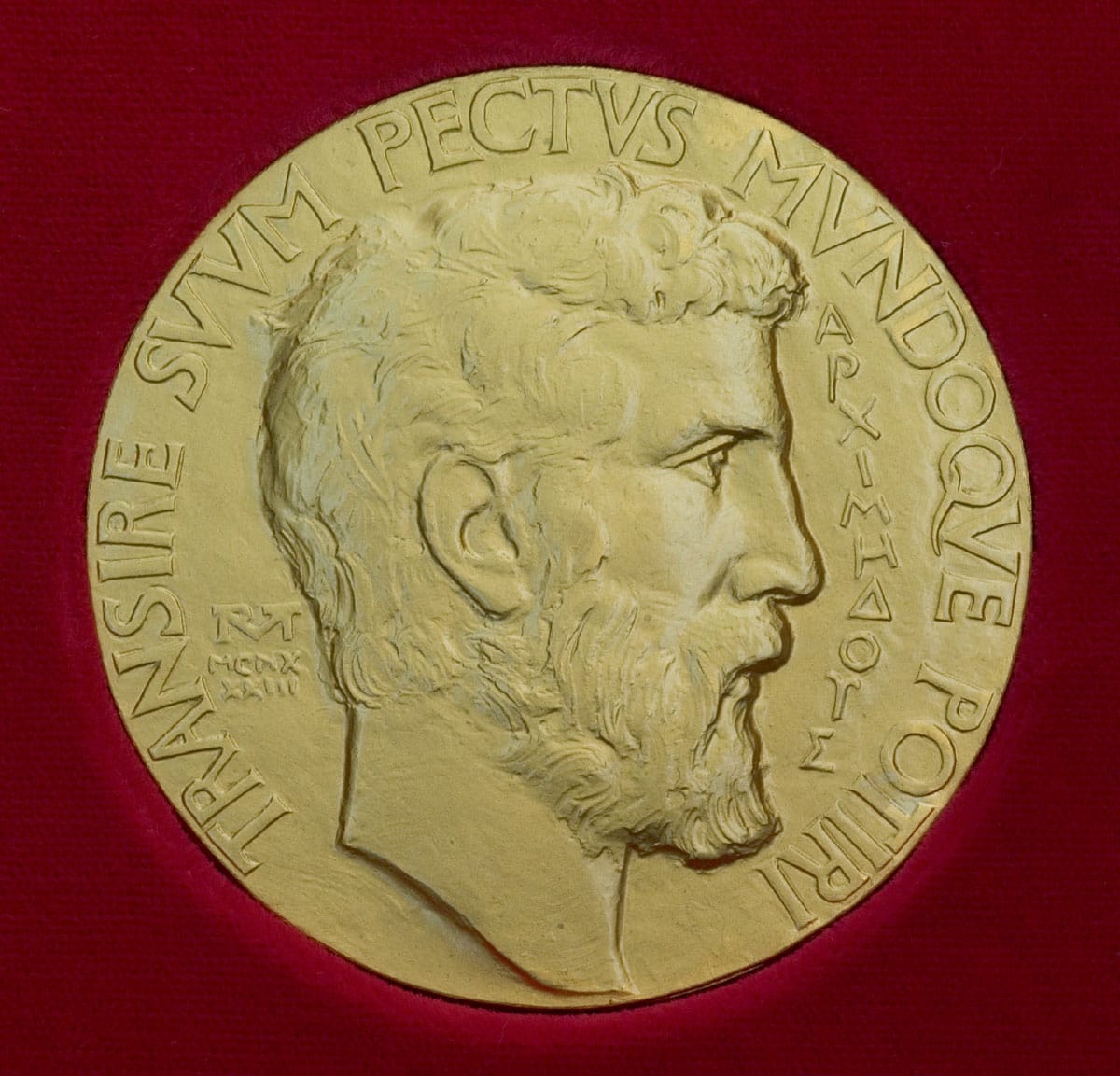
Gold coin featuring Archimedes.
Neil Buchan-Grant/APA
Further south again, near the sports stadium, are a series of (closed) catacombs surrounding the church of Santa Lucia al Sepolcro @ [map] (daily 11am–2pm, 5–7pm; closed on Monday; charge), a Byzantine church founded by San Zozimo, the first Greek bishop of Siracusa, and dedicated to St Lucy, the city's virginal patron saint who was martyred here. Next door, connected by an underground passage, is the octagonal Cappella del Sepolcro, which was constructed in 1630 as a saintly sepulchre.
Porto Piccolo to Porto Grande
On the banks of the Porto Piccolo £ [map], the small harbour, are the scant remains of the city's ancient arsenal. Nearby stands the Byzantine bath-house, where legend has it that Emperor Constans was assassinated with a soap dish in AD 668. On Piazzale del Foro Siracusano, just behind the port, is the original Greek agora $ [map] of Acradina. This was the commercial centre of the Greek city but sadly suffered bombing by both the Allies and the Luftwaffe in 1943. At its centre is a war memorial.
Further west lies the ruins of the Ginnasio Romano % [map], the Roman gymnasium (daily 9am–1pm; closed public holidays), a 1st-century theatre and shrine occupying a picturesquely flooded spot. Although its origins are obscure, the shrine was conceivably dedicated to oriental deities. The raised portico is well preserved and shimmers obligingly.
Nearby, the Porto Grande ^ [map], where Dionysius defeated the Athenian navy in 415 BC, has become a busy mercantile harbour and pleasure port, with a new yacht marina under construction.
Ortigia
A stroll across the main bridge, Ponte Nuovo, leads past bobbing boats and pastel-coloured palazzi to the Darsena, the inner docks. This is the tiny but atmospheric island of Ortigia, jutting into the Mare Ionio, the Ionian Sea. Rivalled only by Ragusa as a centre of aimless wandering, this largely pedestrianised island is the place for leisurely lunches, summer promenades and dreamy ruminations amid crumbling history.
Tip
One excursion worth considering is a short cruise from Porto Grande around Ortigia, following the coastline and fascinating fortifications. Several boat companies on Porto Grande ply their wares but, as in classical times, remember that bargaining is a Sicilian art form.
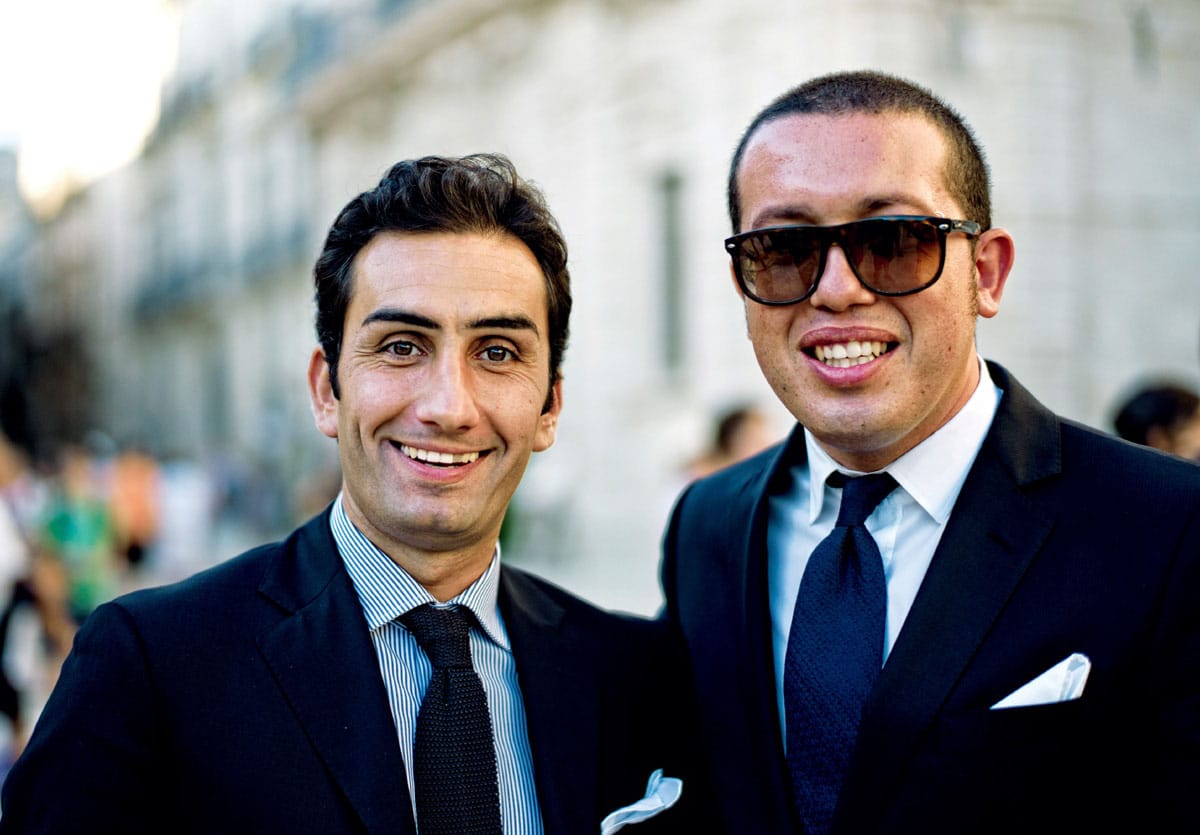
Siracusians.
Neil Buchan-Grant/APA
Graced with two natural harbours, fresh springs and the blessing of the Delphic oracle, this seductive island was dedicated to the huntress Artemis, with the chief temple known as “the couch of Artemis”. In Christian times, the goddess fused with St Lucy, the city's patron saint, and her cult is still venerated in city festivals.
Heralding the entrance to Ortigia is the Tempio di Apollo & [map] (Temple of Apollo), sunken and dishevelled but still the oldest city temple in Sicily. This Doric temple was built in 565 BC and discovered by chance in 1862. It is dedicated to Apollo, whose name is legible on the steps of the base. The squat temple has accrued Byzantine and Norman remains, and is thought to have functioned as both a church and a mosque.
Shop
Traditional craft specialities include the brightly decorated wooden puppets (pupi) connected with both Siracusa and Palermo. On Ortigia, visit the Bottega del Puparo (Via della Giudecca 19; tel: 0931 465 540, www.pupari.com).
In the maze of streets behind the temple is San Pietro * [map], supposedly founded by St Peter before being converted into a Byzantine basilica. The 8th-century apses and blind arcading are incorporated into a 15th-century shell. Just west, Via XX Settembre contains tracts of the massive Greek walls. Dionysius was an indefatigable builder, and the immense wall, 5km (3 miles) in length, was built in 20 days by 60,000 men on double time, and is still visible in other parts of the town.
Ortigia's centre
From the temple, it is a short stroll along Via Roma to Piazza Archimede, the grandiose centre of Ortigia. This Baroque stage set, adorned by a decorative fountain, is home to dignified mansions and open-air cafés. On the next square awaits the magnificent Duomo ( [map] (daily 8am–noon, 4–7pm). This 5th-century temple to Athena was converted into a Christian cathedral in AD 640. Classical columns bulge through the external walls in Via Minerva, a sign that the temple has only been encased in a church since the 7th century. Before then, the temple was a beacon to sailors, with its ivory doors and a gold facade surmounted by the goddess Athena bearing a glinting bronze shield.
Ortigia's reawakening
After decades of neglect, Ortigia is slowly returning to its ancient splendour. The most charming part of Siracusa is already awash with waterfront bars and cosy restaurants, but now the locals are moving back, turning Baroque palaces into boutique hotels and upmarket B&Bs. Creeping gentrification is taking place everywhere, attracting a more enlightened generation, particularly young professionals in search of urban charm.
The transformation is far from complete. Despite EU funds earmarked for Ortigia's restoration, the city's bureaucratic lethargy and lobbying by vested interest groups mean that many projects remain stalled, including the marina at Porto Grande. But rather than grumbling, entrepreneurial citizens are exerting pressure for urban renewal, with the waterfront promenades a success story in the making. Even if parts of the Lungomare di Levante are still to be restored, this moody promenade makes a glorious seafront stroll in any season. The classic stroll leads to the newly restored Castello Maniace, now a museum and events centre, and winds its way round to Fonte Aretusa and the promenade of Lungomare di Ponente on the western side of Ortigia.
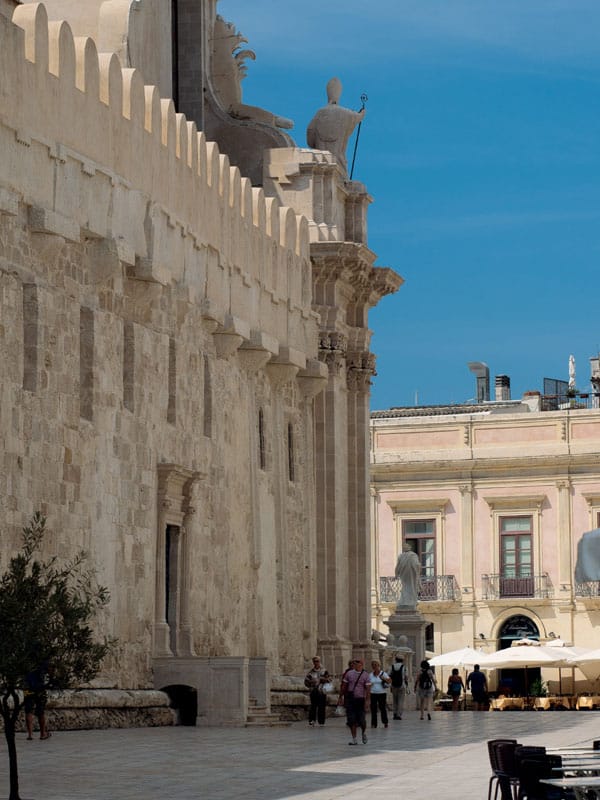
Outside Siracusa's Duomo.
Neil Buchan-Grant/APA
The exterior conjures up a unique spell: a rich Baroque facade (1754) with dramatic chiaroscuro effects, including an inside porch boasting twisted barley-stick columns. Yet the cool, striking interior betrays its Greek origins; the worn but lovely fluted Doric columns set into the outer walls belong to the Temple to Athena. Notwithstanding a Greek soul, the temple also glorifies later conquerors. A Greek baptismal font rests on Norman bronze lions; above is a medieval wood-panelled ceiling; a Baroque choir and Byzantine apses strike newer notes; only the Arab presence is missing. The apses were slightly damaged in the 1991 earthquake, but the Greek sandstone fluted columns survived. In the side chapel, Cappella del Crocifisso, is a painting of St Zosimus by Antonello da Messina, and one of St Marcian attributed to the school of Antonello, also believed to have painted the 13 panels in the Sagrestia (Sacristy).
Virtually next door is the church of Santa Lucia alla Badia, which is now home to Caravaggio's masterpiece The Burial of St Lucy (1608). Also in Piazza del Duomo is the Palazzo Vermexio (1633), the Municipio (Town Hall), built on the ruins of a small Ionic temple possibly dedicated to Artemis.
Just a short distance away, on Via Capodieci, stands Palazzo Bellomo , [map] the loveliest Catalan-Gothic mansion in Ortigia, and the city's compact art gallery, Galleria Regionale (Tue–Sat 9am–7pm, Sun 9am–1pm; charge).
Inside, an elegant courtyard leads to the intimate gallery housing Antonello da Messina's remarkable Annunciation (1474) and the grandiose funerary monument for Eleonora Branciforte d'Aragona by Giovan Battista Mazzolo. Other highlights include 14th- to 18th-century works, from Byzantine icons to Catalan and Spanish paintings, Renaissance tombs and important pieces in gold, silver, coral, ceramics and terracotta.
Fonte Aretusa
At the southern end of Via Capodieci is Fonte Aretusa ⁄ [map], a freshwater spring that is the symbol of Siracusa. Legend has it that the nymph Arethusa, a follower of great Olympian deity Artemis (Diana), was loved and pursued by the river god Alpheius after she bathed in his waters in the Peloponnese.
As she fled from his embrace to Sicily, she prayed to Artemis for help and, on reaching Ortigia, was changed by Artemis into a spring called Arethusa (Aretusa). Alpheius, however, did not give up. He flowed below the sea and mingled his waters with hers. Whether this was rape or the uniting of lovers, Siracusani continue to disagree.
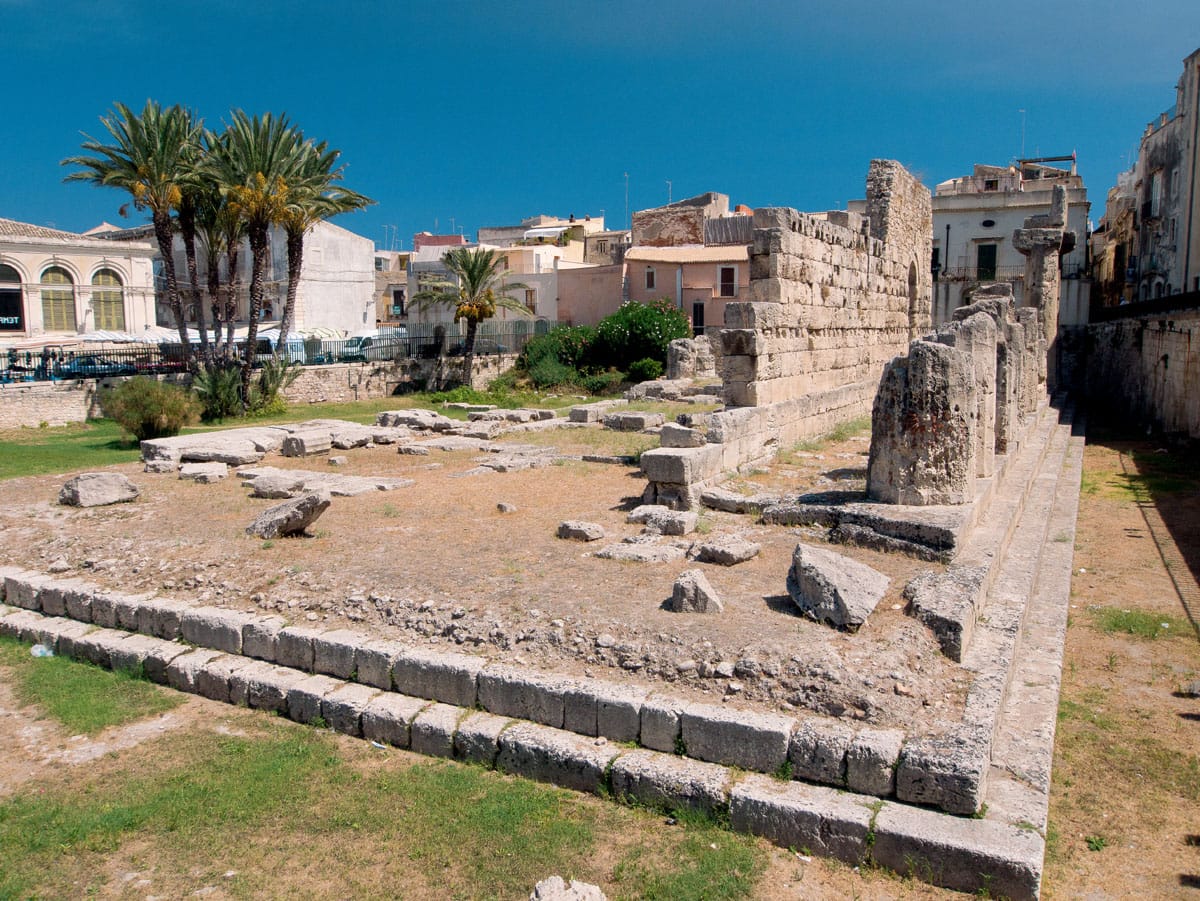
Temple of Apollo.
Neil Buchan-Grant/APA
After a 17th-century earthquake, however, the spring is supposed to have mingled with sea water but, in reality, Ortigia has an abundance of fresh water coming from the Iblei mountains through a peculiar geological land fault. Many houses have serviceable wells.
In any case, ducks make the clumps of reedy papyrus plants in spring water a romantic love nest. At night, the fountain sees a parade of Siracusa's youth, accompanied by flirtation and the obligatory stop for a water-ice nearby. In 1798 Admiral Nelson's fleet drew water at the fountain before proceeding to Malta and then on to the battle of the Nile.
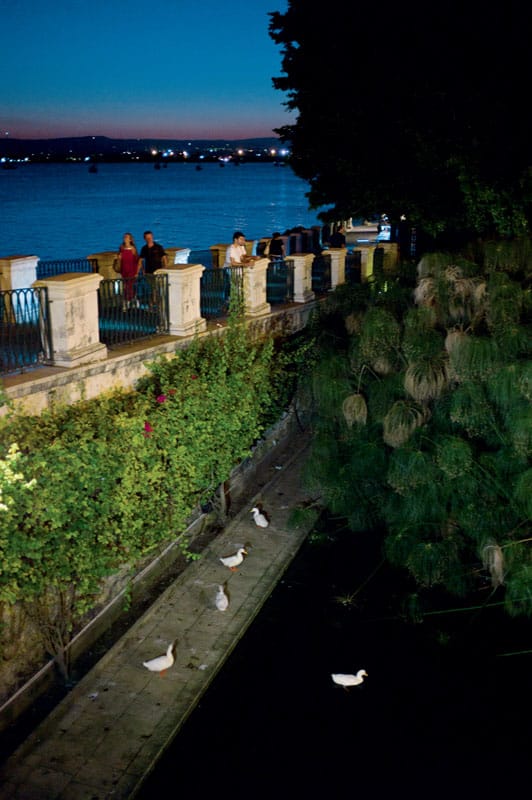
Strolling at Fonte Aretusa at night.
Neil Buchan-Grant/APA
From Fonte Aretusa, the panoramic terraces of Passeggio Adorno lead back to the Porto Grande quays via the Porta Marina archway, one of the city gates created in the 15th-century Spanish fortifications. Known as the Lungomare di Ponente, this charming promenade makes a lovely stroll. The triumphal archway itself leads to the Catalan-Gothic Quarter, centred on Santa Maria dei Miracoli. Set off Via Savoia, this finely sculpted 15th-century church is a prelude to lunch at one of the seafood inns tucked into the side streets.
Eat
Some of Siracusa's most atmospheric restaurants are in the back streets of Ortigia. Specialities include seafood, especially swordfish and shrimps, stuffed artichokes and stimpirata di coniglio, a rabbit and vegetable flan.
Lungomare di Levante
The other side of the island is skirted by Lungomare di Levante, the atmospheric eastern waterfront, easily approached via the Temple of Apollo. The waterfront borders the Arab Quarter, with its tortuous, narrow streets designed to create breezes and keep homes cool even in summer.
You can also get to the Lungomare from Piazza Archimede, along Via della Maestranza and the old guilds’ quarter, graced with Spanish palaces that have been reborn as gracious B&Bs or bohemian bars. Amid the sombre courtyards and swirling sculpture, local pasticcerie literally represent the icing on the cake. There is a vegetable and fish market on the Lungomare on weekday mornings.
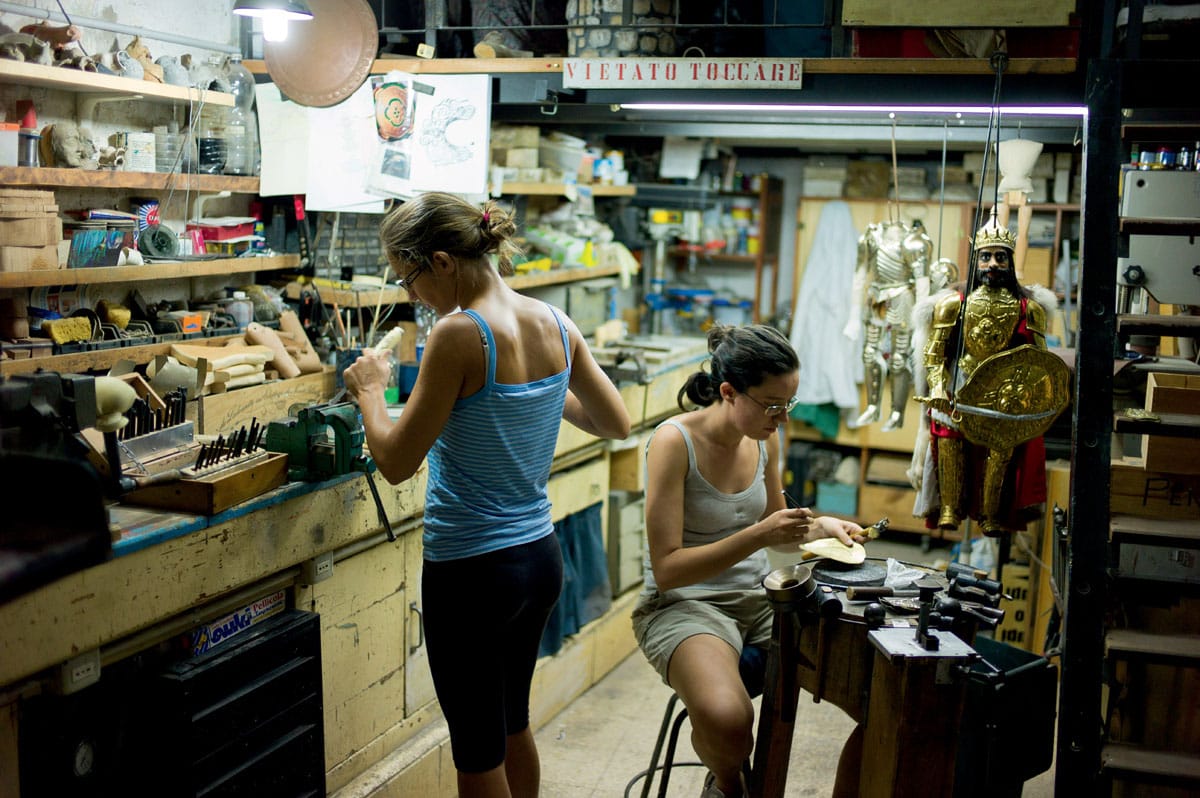
Puppet workshop.
Neil Buchan-Grant/APA
On the southernmost tip of Ortigia, the fortified hulk of Castello Maniace ¤ [map] (daily 9am–1.30pm) dominates the promontory and once served as protector of Siracusa's two shores. Constructed in 1239 by Frederick II, it takes its name from the Byzantine general Giorgio Maniace, who was in charge of the city's defences. Even if largely empty, the Swabian castle is a magnificent monument in terms of ambition and scale. By the northwest tower is the castle's secret freshwater supply, the Bagno della Regina, a chamber fed by a freshwater spring which was fundamental to the siting of the castle here.
Until 2001 the fortress was an army base, but is now open to the public, apart from one section that houses Italy's art police, responsible for recovering (or safeguarding) national treasures.
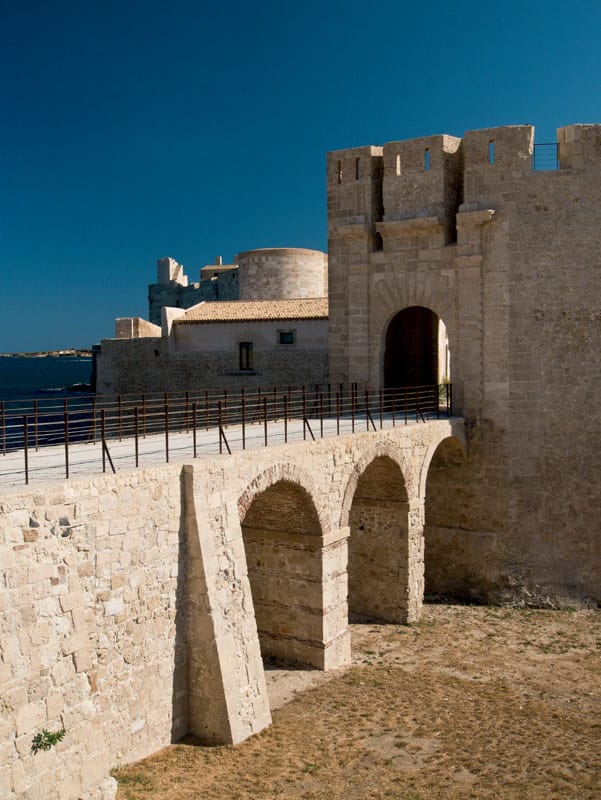
Castello Maniace.
Neil Buchan-Grant/APA
While the castle was a major military base, the troops stationed here played an important role in anti-Mafia campaigns in the 1990s. Temporary exhibitions and summer concerts are also staged here.
Great escapes
Close to the city are sandy beaches and two unique spots, a Greek castle and a dreamy riverscape of papyrus plantations. Alternatively, to sample Siracusa's funky urban beach, you can join the locals on the Ortigia pontoons built over the waterside at Forte Vigliena.
South of Siracusa, off the SS115 (the route to Noto and Módica), lie popular beaches at the small resorts of Arenella, Ognina and Fontane Bianche. Although Siracusa's beaches tend to be full of golden bodies rather than golden sands, a more atmospheric swimming spot is 20km (12 miles) north of Siracusa, past Augusta, at Brùcoli. It is a rocky beach set around a Spanish castle that enjoys views of Etna on clear days.
In ancient Epipolae, 8km (5 miles) northwest of Siracusa, is Castello Eurialo (daily 9am–4pm, Sun 9am–1pm); follow signs to Belvedere). The fort represented the fifth component of the Greek pentapolis and was the most magnificent of Greek military outposts. Designed by Dionysius, the castle protected Siracusa's most exposed flank, the conjunction of the northern and southern city walls.
Apart from amazingly solid masonry and moats hewn out of the rock, the castle had labyrinthine passageways and a keep surrounded by five towers. As a final security measure, the sole entrance was concealed by a patchwork of walls. When Dionysius was in residence, he would not allow his wives into his bed unless they were first searched. According to legend, his bed was surrounded by a moat, and his wives reached it across a little wooden drawbridge, which he then drew up.
Fonte Ciane
South of the city, after 5km (3 miles) is Fonte Ciane (Spring of Ciane), a picturesque spot close to the ruined Temple of Olympian Zeus. (Follow signs to Fonte Ciane.) Ciane is the mythical spring and pool dedicated to the water-nymph Ciane (Cyane), who dissolved into her own pool with grief as she wept, having failed to prevent the rape of Persephone by Hades who had risen from the Underworld through the pool.
Canoes, easily rented from the tiny riverside marina from March onwards, are a way to explore the relaxing rivers, framed by canopies of lush foliage. The bohemian boutique hotel of Caol Ishka is on the neighbouring Anapo river and can book trips for guests, as well as gourmet dinners.
The Ciane weaves through groves of papyrus with tendrils as delicate as cobwebs. The origins of this wild plant are obscure: it was either imported from Egypt or native to Siracusa. Either way, its habitat is endangered, but it flourishes in this idyllic backwater.
Tip
For many visitors Siracusa is the place for market shopping. Best bets are the markets (daily except Sunday) on Ortigia, on the Lungomare close to the Tempio di Apollo, and the larger, rambling general market, La Fiera, on the outskirts, on Via Algeri. Coaches bring in the crowds from the surrounding towns and villages, so you will not be alone.
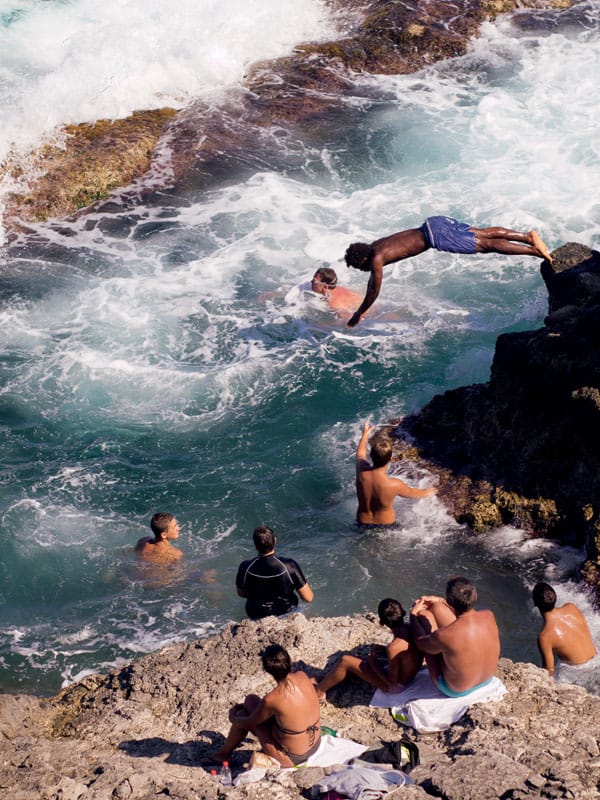
Swimming near Ortigia.
Neil Buchan-Grant/APA
Best Restaurants, Bars and Cafés
Siracusa is benefiting from the popularity of the Val di Noto. Partly as a result, the city restaurants and cafés tend to be diverse and atmospheric, especially on the island of Ortigia.
Antico Caffè Minerva
Via Minerva 15
Tel: 0931 22606 €
One of the oldest in the city. Enjoy their specialities in the tearooms or at tables outside.
Archimede
Via Gemellaro 8 Ortigia
Tel: 0931 69701
A reliable restaurant in Siracusa with friendly service; the menu is interesting but seafood predominates. There is always an array of subtle (and fishy) antipasti. Pizza too. Closed Sun, except Mar–Nov.
Cantinaccia
Via XX Settembre 13
Tel: 333 351 2113 €€€
Rustic cooking, good pasta and meat dishes served on a pretty veranda facing sea and garden. Closed Tue, except in summer.
Castello Fiorentino
Via del Crocefisso 6
Tel: 0931 21097 €
The town's most popular pizzeria can be chaotic and you may have to queue, but it's really good value and the superb pizzas are worth the wait. Closed Mon.
Da Mariano
Vicolo Zuccala’ 9
Tel: 0931 67444
www.osteriadamariano.it €€–€€€
Set in the heart of Ortigia, this inn offers typical Sicilian dishes, both meat and fish.
Darsena da Iannuzzo
Riva Garibaldi 6, Ortigia
Tel: 0931 61522
Just across the bridge, this bold, bright, popular trattoria serves the freshest fish and local dishes. Closed Wed.
Don Camillo
Via Maestranza 46
Tel: 0931 67133
www.ristorantedoncamillosiracusa.it €€€
Highly regarded. Extensive wine cellars. Closed two weeks July.
Don Carmelo
Via Claudio Maria Arezzo 7
Tel: 0931 483 633 €€
This popular Ortigia spot serves pasta, pizza, crepes and Mediterranean-style cuisine.
Enoteca Solaria
Via Roma 86, Ortigia
Tel: 0931 463 0047
Wine bar and shop where food is served. A fine place to try local wines.
La Foglia
Via Capodieci 29 Ortigia (close to Fonte Aretusa)
Tel: 0931 66233
www.lafoglia.it €€€
Vegetarians welcomed. Sicilian and fish dishes also served. Owned by an artist and reflected in the profusion of paintings and statuary, plus the antique glasses. Try the subtle seafood. Closed Tue, except in summer.
La Gazza Ladra
Via Cavour 8
Tel: 340 060 2428
This small, family-run trattoria uses the freshest of local ingredients in their daily fish specials and generous plates of antipasti. Closed Mon.
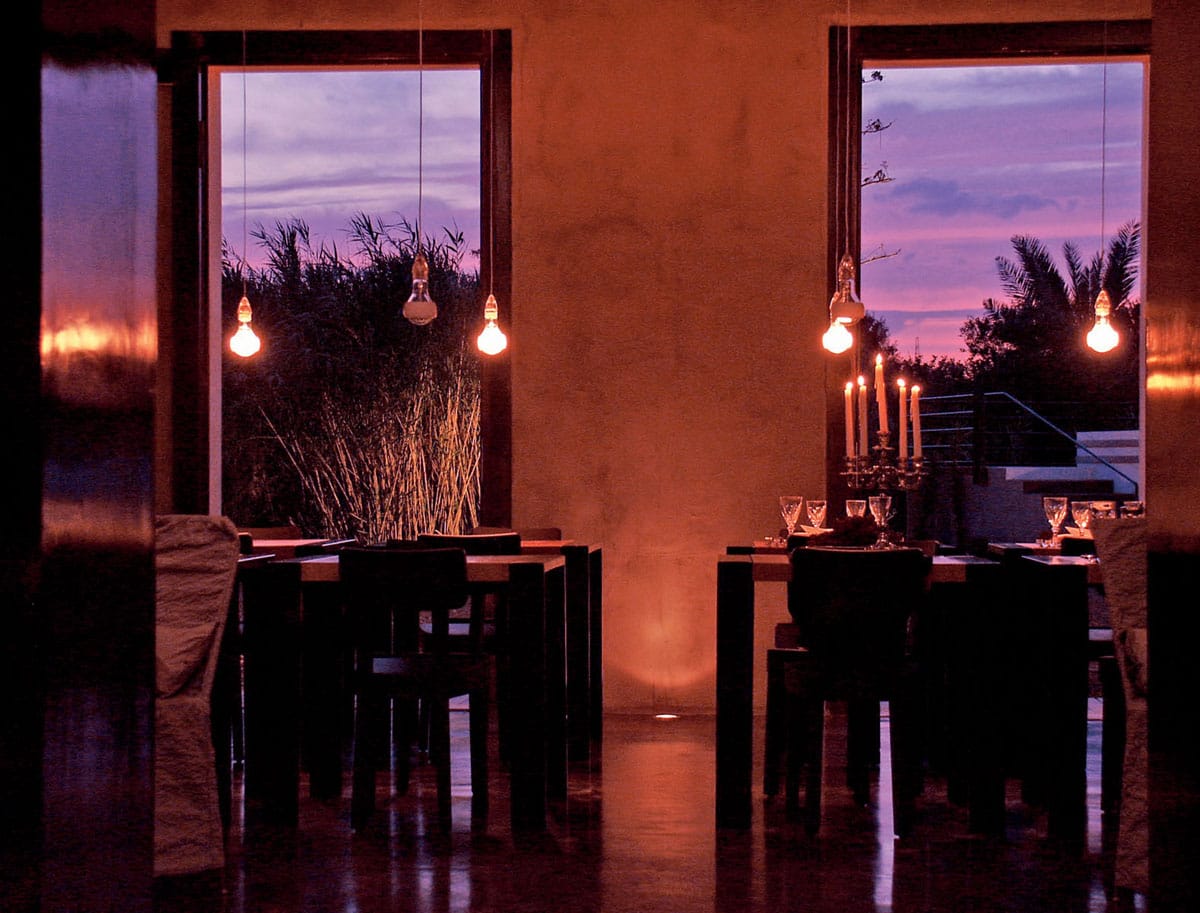
Zafferano.
Zafferano
Gran Caffè del Duomo
Piazza del Duomo 18
Tel: 0931 21544 www.grancaffedelduomo.com €
A typical pasticceria and bar. Try their ricotta filled pastries if you crave something sweet.
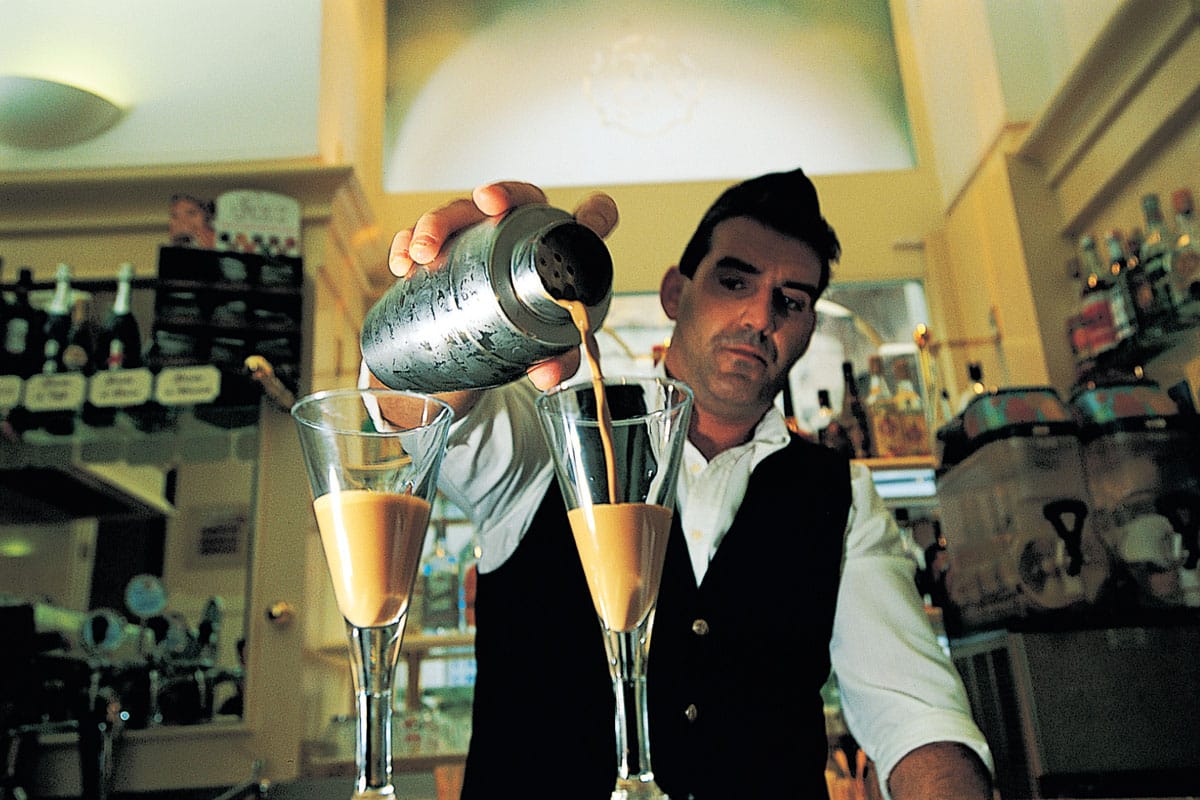
Iced coffee Sicilian-style.
Gregory Wrona/APA
Medusa
Via Santa Teresa 21
Tel: 0931 61403 €€
A delicious blend of Sicilian and Tunisian dishes. Lots of fish. Closed Mon and two weeks in Aug.
Minerva
Piazza Duomo 20
Tel: 0931 69404 €€
Conveniently placed for lunch after a cathedral visit. Closed Mon.
Osteria da Mariano
Vicolo Zuccolà 9, Ortigia
Tel: 0931 67444
Set off Fonte Aretusa, this wholesome trattoria is far stronger on the meaty cuisine of the Iblei mountains. The menu runs from ricotta sprinkled with pistachio nuts to meaty mains and the house dessert made of sesame biscuits and fortified wine. Closed Tue.
II Podere
Traversa Torre Landolina 11
Tel: 0931 449 390 €–€€
Dinner in a charming masseria(country manor) with low-key Sicilian cuisine.
Porticciolo
Via Trento
Tel: 0931 61914 €€
Near the market. Offers delicious mixed-fish grills or fresh lobster. Closed Mon and 10 days in Nov.
Spiaggetta
Viale dei Lidi 473, Fontane Bianche
Tel: 0931 790 334 €€
Modern and welcoming with windows overlooking the picturesque creek. Sicilian dishes, pizzeria. Closed Tue in winter.
Taverna Sveva
Piazza Federico di Svevia 1–2
Tel: 0931 24663 €€
Try the gnocchi with pistachio or the fish dishes, and sit outside in fine weather.
La Terrazza sul Mare
Grand Hotel Ortigia, Viale Mazzini 12
Tel: 0931 464 600 €€€
Traditional Sicilian cuisine done superbly well, especially the seafood. Elegant yet relaxing setting on the rooftop by the marina. A romantic place for dinner. Friendly yet highly professional.
Tinkitè
Via della Giudecca 63
Come for a bite for breakfast in this boho bar, and probably return for nibbles at cocktail hour, when the locals mingle over aperitivi, or even pop in for tea in the afternoon. Open 10am–midnight, closed Wed.
Zafferano
Caol Ishka, Via Elorina 154
Tel: 0931 69057 €€–€€€
Set in a funky design hotel on the peaceful outskirts of Siracusa, this elegant contemporary restaurant reflects the creative setting. Expect charming service and a subtle mix of flavours, with Sicilian dishes infused with a touch of exoticism.
Zsa
Piazza Galermi 22,
Tel: 0931 464 280 €€
Siracusan specialities: grilled swordfish, seafood risotto, pasta (with pine nuts, sultanas and anchovies) and local. Closed Mon.
